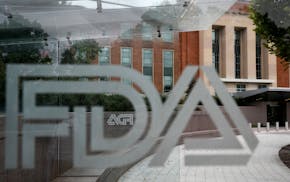For years, visitors to the St. Paul RiverCentre's boardroom have sweltered from heat buildup from the summer sun. To solve this problem, the center installed "smart glass" windows last month — 26 in all — that can be tinted depending on the level of sun.
The installation is part of the RiverCentre's three-year sustainability plan, nicknamed "80-20 in three." The plan began in April 2010 to reduce the conventions center's carbon footprint by 80 percent and become 20 percent more efficient than an average building of like size.
Jim Ibister, RiverCentre general manger, said the new windows will lower the cost to cool the room in the summer and manage sunlight better in the winter.
The high-tech windows are the most recent — and most visible — example of energy-saving improvements designed to meet the center's ambitious energy agenda.
"We think we will hit [the goal] this year, though we will be a few months behind," Ibister said.
The windows, manufactured by Sage Electrochromics in Faribault, Minn., can be set to automatically switch from four set points of tint. This is expected to prevent the heat buildup during the summer, saving energy in the process. The energy-saving feature of the windows is their thin ceramic coating, which tints the glass when activated by a current of low-voltage electricity.
Derek Malmquist, Sage Electrochromics vice president of marketing, said "the project is a retrofitting. The building and room already existed, we came in to correct a problem."
Global initiative
The RiverCentre's sustainability plan is one local example of a global initiative to rein in pollution and reduce energy consumption in commercial and industrial buildings.
This month, Maplewood-based 3M Co. joined Sage Electrochromics in an international clean-energy consortium between the U.S. and China. The consortium, which was launched in 2009 by President Obama and Hu Jintao, then president of China, is called the U.S. China Clean Energy Research Center.
Each country, through public and private funding, contributed $75 million to the fund, in hopes of facilitating "joint research and development on clean-energy technology."
The consortium estimates that in the next 20 years, China will build more square footage of floor space than the current total in the United States. The goal to make those buildings as energy efficient as possible.
"Both countries," the consortium says, "have large domestic coal reserves and use coal to generate the majority of their electricity [roughly 50 percent in the U.S. and 80 percent in China]."
In 2012, Sage Electrochromics hired an executive to manage its operations in China.
"As China continues to build out its urban centers, architects and building owners are looking for a balance of sustainability and energy efficiency while still advancing bold designs with an abundant use of glass," the company said in a statement at the time.
Pike Research, which studies emerging technologies for international companies, estimates that the market value of smart glass will reach at least $700 million by 2020.
In line with the expansion of the smart-glass market, Sage Electrochromics recently opened a new $150 million factory in Faribault, positioning itself to ramp up sales of its variable-tint glass in the United States.
To build its new factory, Sage in 2010 received a $72 million loan guarantee and a $31 million tax credit from the Department of Energy.
RiverCentre's Ibister said the windows' installation is part of a trial to assess the windows' effectiveness in the RiverCentre's boardroom. Total cost for the window was "between $40,000 and $50,000," Ibister said.
Industry experts expect that as Sage Electrochromics' factory accelerates its production, the costs of the windows will go down, securing a spot in the blueprints of buildings to come.
The windows were added after the RiverCentre assessed its other utilities. "We got a firm to come in, to make sure all our systems are meeting efficiency standards," Ibister said.
LEED certification
"If we can do business with Minnesota vendors that are providing state-of-the-art technology it's great," said Rich Ginsberg, a board member at the St. Paul RiverCentre.
Ginsberg added that the goal of the center's sustainability plan is to be LEED-certified, to show that the RiverCentre is more efficient than buildings simply built to code. LEED stands for Leadership in Energy and Environmental Design; standards are set by the U.S. Green Building Council.
Helping RiverCentre's sustainability plan is the source of its heating and air-conditioning needs. Both are provided by District Energy St. Paul, a utility that derives 70 percent of its energy from renewable biomass.
District Energy St. Paul provides energy for 200 businesses, including United Hospital, Regions Hospital, the St. Paul Hotel, Ecolab and St. Paul City Hall.
"RiverCentre has set some aggressive sustainability goals [that] will raise the bar for other venues to follow," Mayor Chris Coleman said in a statement.
Steve Fischer is a University of Minnesota student reporter on assignment for the Star Tribune.

Senate passes bill forcing TikTok's parent company to sell or face ban, sends to Biden for signature
USPS commits to rerouting Reno-area mail despite bipartisan pushback and mail ballot concerns

